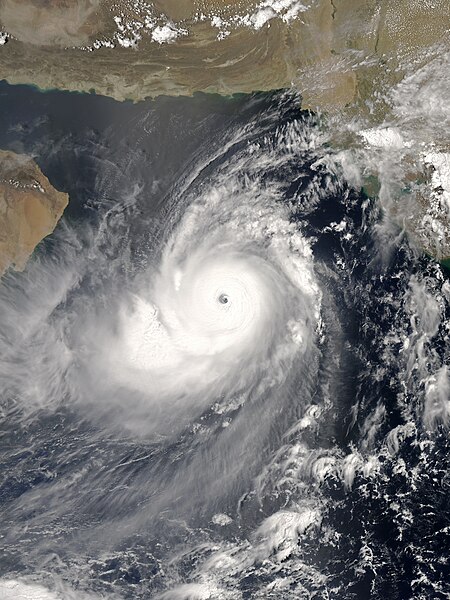Photos • Location


Size of this preview:
450 × 600 pixels. Other resolutions:
180 × 240 pixels |
360 × 480 pixels |
576 × 768 pixels |
768 × 1,024 pixels |
1,536 × 2,048 pixels |
5,550 × 7,400 pixels.
Original file (5,550 × 7,400 pixels, file size: 9.84 MB, MIME type: image/jpeg)
File history
Click on a date/time to view the file as it appeared at that time.
| Date/Time | Thumbnail | Dimensions | User | Comment | |
|---|---|---|---|---|---|
| current | 10:05, 27 October 2016 |
 | 5,550 × 7,400 (9.84 MB) | Meow | Optimised from the original TIFF file under current standards. |
| 04:55, 15 November 2007 |
 | 6,000 × 7,800 (7.7 MB) | Good kitty | == Summary == {{Information |Description=You might expect to see a storm with near-perfect symmetry and a well-defined eye hoovering over the warm waters of the Caribbean or in the South Pacific, but Tropical Cyclone Gonu showed up in an unusual place. On |
File usage
The following pages on the English Wikipedia use this file (pages on other projects are not listed):
- 2007 North Indian Ocean cyclone season
- Cyclone
- Cyclone Gonu
- List of Arabian Peninsula tropical cyclones
- List of the most intense tropical cyclones
- North Indian Ocean tropical cyclone
- Tropical cyclones in 2007
- Wikipedia:Featured picture candidates/June-2013
- Wikipedia:Featured picture candidates/Super Cyclonic Storm Gonu
- Wikipedia:Main Page history/2019 September 6
- Wikipedia:Today's featured article/June 2010
- Wikipedia:Today's featured article/June 3, 2010
- Wikipedia:Today's featured list/September 2019
- Wikipedia:Today's featured list/September 6, 2019
- Portal:Iran/Selected article/5
- Portal:Tropical cyclones
- Portal:Tropical cyclones/Anniversaries/June
- Portal:Tropical cyclones/Anniversaries/June/4
Global file usage
The following other wikis use this file:
- Usage on bn.wikipedia.org
- Usage on de.wikipedia.org
- Usage on es.wikipedia.org
- Usage on fa.wikipedia.org
- Usage on fr.wikipedia.org
- Usage on id.wikipedia.org
- Usage on ko.wikipedia.org
- Usage on nl.wikipedia.org
- Usage on pt.wikipedia.org
- Usage on uk.wikipedia.org
- Usage on vi.wikipedia.org
- Usage on zh.wikipedia.org

Size of this preview:
450 × 600 pixels. Other resolutions:
180 × 240 pixels |
360 × 480 pixels |
576 × 768 pixels |
768 × 1,024 pixels |
1,536 × 2,048 pixels |
5,550 × 7,400 pixels.
Original file (5,550 × 7,400 pixels, file size: 9.84 MB, MIME type: image/jpeg)
File history
Click on a date/time to view the file as it appeared at that time.
| Date/Time | Thumbnail | Dimensions | User | Comment | |
|---|---|---|---|---|---|
| current | 10:05, 27 October 2016 |
 | 5,550 × 7,400 (9.84 MB) | Meow | Optimised from the original TIFF file under current standards. |
| 04:55, 15 November 2007 |
 | 6,000 × 7,800 (7.7 MB) | Good kitty | == Summary == {{Information |Description=You might expect to see a storm with near-perfect symmetry and a well-defined eye hoovering over the warm waters of the Caribbean or in the South Pacific, but Tropical Cyclone Gonu showed up in an unusual place. On |
File usage
The following pages on the English Wikipedia use this file (pages on other projects are not listed):
- 2007 North Indian Ocean cyclone season
- Cyclone
- Cyclone Gonu
- List of Arabian Peninsula tropical cyclones
- List of the most intense tropical cyclones
- North Indian Ocean tropical cyclone
- Tropical cyclones in 2007
- Wikipedia:Featured picture candidates/June-2013
- Wikipedia:Featured picture candidates/Super Cyclonic Storm Gonu
- Wikipedia:Main Page history/2019 September 6
- Wikipedia:Today's featured article/June 2010
- Wikipedia:Today's featured article/June 3, 2010
- Wikipedia:Today's featured list/September 2019
- Wikipedia:Today's featured list/September 6, 2019
- Portal:Iran/Selected article/5
- Portal:Tropical cyclones
- Portal:Tropical cyclones/Anniversaries/June
- Portal:Tropical cyclones/Anniversaries/June/4
Global file usage
The following other wikis use this file:
- Usage on bn.wikipedia.org
- Usage on de.wikipedia.org
- Usage on es.wikipedia.org
- Usage on fa.wikipedia.org
- Usage on fr.wikipedia.org
- Usage on id.wikipedia.org
- Usage on ko.wikipedia.org
- Usage on nl.wikipedia.org
- Usage on pt.wikipedia.org
- Usage on uk.wikipedia.org
- Usage on vi.wikipedia.org
- Usage on zh.wikipedia.org

